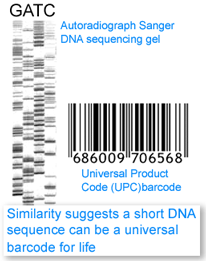In 2003, Paul Hebert and colleagues proposed a universal identification system employing short DNA sequences as identifiers for animal and plant species. Inspired by the Universal Product Code labels that stores use to track merchandise, he named these short sequences “DNA barcodes.” My colleagues and I set down thoughts inspired by this new name:
“Commercial barcodes and the barcode of life
Jesse Ausubel, Mark Stoeckle, Paul Waggoner
September 2004
 Although new methods of sequencing and visualization have displaced the one that produced autoradiographs that show blurry gray stripes of a gel indicating presence or absence of particular bits of DNA, the analogy between the commercial barcode and the barcode of life may be traced to it. However, the power of the analogy comes from other similarities: large capacities to differentiate mind-boggling diversity, ability of digits to distinguish unambiguously, rapidity and economy of identification, ability of parts of the code to distinguish categories, and avoidance of a Tower of Babel by uniformity. We elaborate briefly.
Although new methods of sequencing and visualization have displaced the one that produced autoradiographs that show blurry gray stripes of a gel indicating presence or absence of particular bits of DNA, the analogy between the commercial barcode and the barcode of life may be traced to it. However, the power of the analogy comes from other similarities: large capacities to differentiate mind-boggling diversity, ability of digits to distinguish unambiguously, rapidity and economy of identification, ability of parts of the code to distinguish categories, and avoidance of a Tower of Babel by uniformity. We elaborate briefly.
Without the final digit that checks accuracy, the quartets of bars and spaces in the Universal Product Code (UPC) have 10 alternatives at 11 locations, creating an ample 1011 capacity to identify manufacturers and their products. Instead of operating in quartets, sequences of CATG operate in trios that specify synthesis of an amino acid. Each trio of the four alternative CATG has 43 or 64 alternatives. A 600-unit sequence of DNA comprising 200 trios with 64200 alternatives opens ample capacity to identify millions of species. Such large capacities are needed to differentiate the diversity of an economy or a forest.
Because one product number in a UPC differs from another by discrete, digital steps rather than by the shades of verbal descriptions, the numbers identify the product–unambiguously. A barcode of life written as a sequence of CATG along a uniform locality of genomes differs from another by four discrete, unambiguous steps rather than by gradations of words, shapes, and colors. Barcodes gain power because digital beats analogue at making unambiguous distinctions.
Speed and economy also propel use of barcodes. Behind the beep of a UPC scanner lies orchestration that began with the initial conception of bars for numbers a half-century ago. Users and inventors orchestrated optics, electronics, and software to develop miniature, robust equipment that made the barcode an affordable master key to supermarket inventories and suppliers (Swartz 1999). Now that the price of DNA identification of a species has fallen to about $10 (Randhawa 2004), the orchestration can begin to provide a barcode of life. Uniformity fosters frequent use and thus learning and economy.
Product codes can identify products with increasing resolution. At the first level of resolution, the first bars of a UPC on a carton resolve the manufacturer. At the second level, the last bars resolve the product line. Opening the box and reading the serial number would resolve the individual. In analogous manner, extending a DNA barcode through more and more sequences would resolve from kingdoms to species, subspecies, and finally individuals. For our goal, Ockham’s razor prescribes as short a barcode of life as suffices to distinguish species.
Uniformity bestows the universality implied by the U in UPC. Scanners in hardware, grocery, and convenience stores must all call the same light bulb by the same 12 digits. Recently agreement between America and Europe added a thirteenth digit, made uniformity more widespread, and brought universality closer to realization (NY Times 12 July 2004, page C1). The power of standardization, whether in railroad gauges or typewriter keyboards, is one of the strongest lessons of the history of technology.
Finally, the success of a short DNA sequence distinguishing species will rest on reasoning, testing, and agreement, not just an appealing analogy. Reasoning will select a uniform locality on genomes that varies enough but not too much among species, testing will establish whether barcodes of that uniform locality correspond to established binomial names across several species, and then agreement will foster an expanding compilation of matching barcodes and binomial names.”
I agree when you say that “the power of standardization whether in railroad guages or typewriter keyboards, is one of the strongest lessons of the history of technology”
Talk about standing the test of time… how many years have the two of these been around with ZERO changes?